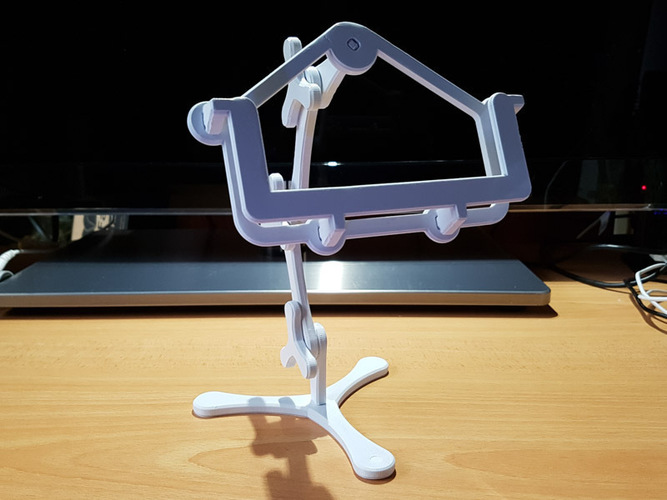
Flexible arm holder
pinshape
I love the old flexible desk lamps. So I decided to create a similar styled holder for my Kindle. Now, you might think they're not that heavy, but when I'm in bed, I need help getting my neck around to read it while it's on my chest. At full stretch, this stand will lift the bottom of the kindle 100mm off the surface, even more if you tilt it back a bit... or less if you prefer. It's also a piece of art on its own. I then decided to make it more versatile as well. Too many parts! Don't be overwhelmed; there are options to choose from. This was originally designed for my Kindle, but then I realized I could make it more generic. I started with a honeycomb infill for the carrier, but that looked cleaner without, so that became an option too. And since friction fit might not work well with some, and doesn't with me if I need to glue things, I built screw versions instead. All in all, there are 8 carrier types and 2 retainers. I should look into making screw versions of the retainer arm, but that's a bit too much for my brain. Here's how you tell the different versions: "KS" in the carrier and retainer filenames indicates a Kindle (Oasis) specific part; "HC" in the carrier filename means it has a honeycomb back; "FRICT" at the beginning of the filename shows friction fit parts; "SCREW" at the beginning of the filename shows screw fit parts. Do you prefer friction or screw parts? If you're unsure about the friction fit, I'd suggest using glue – it's cleaner and more aesthetically pleasing. If you want to try the screw fit options instead, make sure your printer is accurate in the XY plane. Print out the bolts and arms first since they'll be needed anyway. Then print the screw test. If it screws nicely into the bolt hole in the arm, you're good to go. Print Settings: Printer Brand: Ultimaker Printer Model: Ultimaker 2 Rafts: No Supports: No Resolution: 0.2mm Infill: 25% Notes: While everything prints fine at 25%, I recommend printing the nuts and bolts at 100% for added strength. You'll need to print the following: Three bolts Two pins One each of the arms One base One carrier One retainer After Printing: Friction Pins If your printer is prone to creating an "elephant's foot" in the first couple of layers, you may need to clear this out from the pins where they touch up against another surface. You can probably leave it in place for the pin itself as that will add a bit more friction. Custom Section: WARNING: Tolerances This design is based on my printer, which seems well-calibrated, so there's not much tolerance around objects that fit inside other objects. Some of the friction fit pieces here are designed to be a very tight fit for obvious reasons. You may find you need to drill or scalpel out a hole, or use a rubber mallet – despite only being printed at 25% infill, they're remarkably resilient. Thanks I was trying to work out the maths for the inner curves for ages, and then I stumbled upon Rupert Rawnsley's Curvey Door Handle thing. He had the right maths in there. Thanks, Rupert!
With this file you will be able to print Flexible arm holder with your 3D printer. Click on the button and save the file on your computer to work, edit or customize your design. You can also find more 3D designs for printers on Flexible arm holder.
